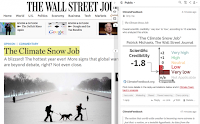The article makes false or misleading statements on several aspects of climate science, including the global temperature record, the methodology for measuring global temperature, the effect of El Niño on global temperature, and the economic impact of climate change. The mention of so many distinct aspects of climate science is intended to allow the author to pass himself off as an authority on climate science, while at the same time bamboozling readers into accepting three startlingly spurious claims.
Claim 1: “It is therefore probably prudent to cut by 50% the modelled temperature forecasts for the rest of this /century.”This is the opinion of the author with no basis in science. Climate models have successfully projected changes in climate observed in recent years. These models are not perfect representations of our climate system, but they are our best tool for forecasting future climate change.
Claim 2: “The notion that world-wide weather is becoming more extreme is just that: a notion, or a testable hypothesis.”The scientific consensus is that some extreme weather events are becoming more severe and occurring with greater frequency in relation with climate change and more importantly these are expected to increasingly affect societies in the future. The author attempts to cast doubt on the science by claiming that the economic cost of extreme weather has remained stable over the past quarter-century. The author misleads the reader into concluding that because the economic cost of extreme weather has not increased, then extreme weather cannot have increased. But this fallacious reasoning is only the tip of the iceberg. Dr Laurens Bouwer, a senior risk analysis advisor at Deltares, told Climate Feedback that the claim that losses caused by severe weather have remained stable over the past 25 years is “not accurate”. It also belies the extent to which insurance agencies recognize the risks that climate change poses. The article cites data from Munich Re, whose head of Geo Risks Research and its Corporate Climate Centre, Professor Peter Höppe, has publicly stated that “climate change is one of the greatest risks facing humankind this century. Through a part of its core business, the insurance industry is directly affected and therefore assumes a leading role in devising solutions for climate protection and adaptation to the inevitable changes.”
Claim 3: “Without El Niño, temperatures in 2015 would have been typical of the post-1998 regime.”This is false. Scientists estimate that the current El Niño event contributed only a few tenths of a degree to the record global temperature observed in 2015. The year would have gone down as the hottest on record even without the El Niño event, as explained in this article by The Carbon Brief.
Patrick J. Michaels would have his readers believe that the observed increase in global temperature, underlined by the news of the hottest year on record, is “business as usual”. His readers should instead draw the conclusion that no matter how conclusive the evidence, climate contrarians like Michaels intend to go about their “business as usual”, casting doubt on the science.
The Wall Street Journal promises potential subscribers to help them “make better-informed decisions” by providing them with “expert commentary and insight”. This op-ed piece is objectively at odds with that ambition.
Many more claims made by Patrick Michaels have been debunked by scientists, read their detailed analysis.
Read more at Climate Scientists' Open Letter to the Wall Street Journal on Its Snow Job

No comments:
Post a Comment